For those who prefer to listen rather than read, this article is also available as a podcast on Spotify.
Contents:
The journey from concept to App Store is often rough. Juggling timelines and budgets, solving all the tricky bugs, adding the essentials, you name it.
As a native iOS app development company, Shakuro delivered more than 500+ successful projects using tech stacks with Swift, Apple frameworks, and best UI practices. And the team knows all these hardships firsthand. It’s also crystal clear that finding the right partner is one of the main trials on the way to glory. With time, you learn how to fix bugs, but dealing with people? Yeah, requires luck and skill.
You see, hiring the wrong dev team can cost you more than just money. It eats up time, drains morale, and leaves you with something that doesn’t quite work the way you envisioned. If you’re reading this, chances are you’re looking for a reliable team. Someone who knows the field inside out, who can guide you through the tricky parts without overcomplicating things, and who’ll actually listen to what you need. But you gotta know what to look for in native iOS development.
So if you’re feeling stuck or overwhelmed or just want to make sure your next move is the right one, stick around. I’m going to break it all down: the good, the bad, and the stuff nobody tells you until it bites you in the back.
What Is Native iOS App Development?
You’ve probably heard the term thrown around at meetups or in investor pitch decks, but it’s worth slowing down and really understanding what it means.
So it’s an app built specifically for Apple devices: iPhones, iPads, Apple Watch, and Apple Vision Pro. Usually, developers use the tools and languages Apple recommends, like Swift or Objective-C, along with Xcode and all the official frameworks. This is the point that differentiates the approach from others, such as cross-platform or hybrid.
The animations are smooth, the buttons respond the way you expect, and everything just flows like you’re using a first-party Apple app. It uses the device to the full, plays nice with the OS, and gives you access to all the latest features Apple rolls out, like Dark Mode, widgets, or even dynamic type resizing.
Native iOS App Development vs Cross-Platform
You already know that the native approach means building your product specifically for iOS using Apple-approved tools like Swift and Xcode. You get an application that runs fast, looks right at home, and integrates smoothly with all the features.
On the flip side, cross-platform solutions like React Native or Flutter let you write code once and deploy on both iOS and Android. Sounds great in theory, but there’s always a trade-off.
They can feel just a little off on iOS, pretending to be native but missing some of the subtle quirks that real iPhone users expect. Animations might not be as smooth, and access to newer iOS features might lag behind. Moreover, if you need deep integration with things like ARKit or Core Data, you’ll hit more friction than you would going fully native.
Now, cross-platform is totally valid if you’re on a tight budget or want to test an MVP across platforms quickly. But if you’re aiming for a polished, high-performance experience on iOS, native is usually the better bet.
Overview of Swift, Objective-C, and Apple’s native SDKs
Swift is Apple’s programming language, introduced back in 2014. It was basically made to replace Objective-C. For native iOS app development, the language feels modern, clean, and way easier to read. It’s fast, safe, and keeps getting better with each new version. Actually, most new apps today are built in Swift.
However, don’t write off Objective-C just yet. The old-school language that powered pretty much every iOS app in the early days is still around because a lot of legacy apps and libraries are written in it. That’s the reason why some companies haven’t fully migrated yet. But the language is more verbose and has that “been around the block a few times” kind of vibe. If you’re starting fresh, you should stick with Swift, but if you’re maintaining an older app or using certain third-party tools, you might still bump into Objective-C here and there.
Then there’s Apple’s native SDKs, which basically means all the built-in tools and frameworks Apple gives developers to build apps. They are similar to Legos, designed specifically for iOS: UIKit, SwiftUI, Foundation, CoreData, AVFoundation, and so on. These are what let you build buttons, animations, data storage, camera access—all the stuff users expect from a real iOS app.
For example, UIKit has been the go-to framework for building interfaces for years, while SwiftUI is Apple’s newer, simpler way to design UI with less code. Depending on your project, you might use one or both. The Shakuro team uses SwiftUI.
What’s great about sticking with these native tools is that they’re constantly updated alongside iOS releases. So when Apple rolls out iOS 18 with some cool new feature, chances are the SDKs will support it right away, and your dev team can integrate it without jumping through hoops.
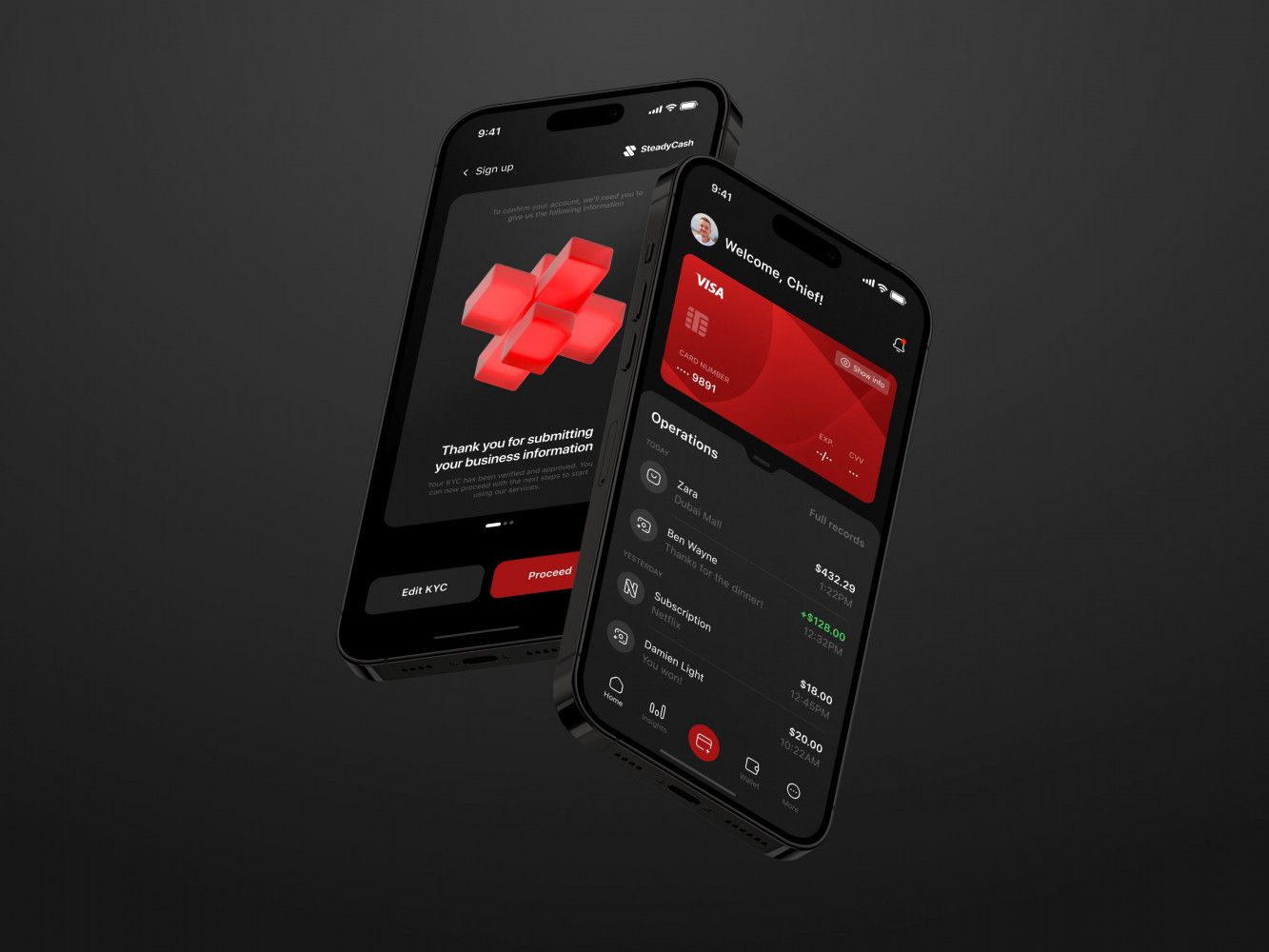
Mobile Banking App by Conceptzilla
Native vs Hybrid Apps: What’s the Difference?
The hybrid route differs from native iOS development because of the content. These apps are basically websites wrapped in an app shell. Or in fancier cases, they mimic native behavior pretty closely. The primary tools are React Native, Flutter, Ionic, Cordova, or similar frameworks. And the idea is simple: write once, run on both iOS and Android. However, the result depends on what you want from your app.
If you’re building a simple to-do list app or a company blog, a hybrid approach will work just fine. It can save time and money, in case you really need to ship something fast or test an MVP in the real battlefield, not a playground.
However, if you need something more complex, like tight integration with the camera, push notifications that actually work reliably across devices, etc., suddenly, you hit the wall. I’m not saying hybrid is bad; it just has its own use cases. For example, if you’re bootstrapping, or testing a concept, or really need to cover both platforms quickly, it can be a smart move.
So what’s the real difference between a hybrid and a native app?
- Performance: Native wins almost every time. It uses the full power of the hardware and OS. A hybrid app often has to translate code through layers, which can slow things down.
- Look and feel: Applications meant for iOS behave like the rest of the phone. Hybrid ones try to imitate that, but sometimes fall short. Buttons that don’t quite bounce right, or menus that feel off.
- Access to features: Want to use Face ID, ARKit, or the latest iOS widgets? Native has it built-in. With hybrid, you’re often waiting for plugins to catch up or writing custom native code anyway.
- Maintenance: Native codebases tend to age better. Hybrid ones depend heavily on third-party tools, which can become outdated or unsupported.
Choosing between native iOS application development and a hybrid one isn’t just a tech decision. It affects your timeline, budget, user experience, and how smoothly things go as your product grows. So here’s a quick breakdown of the pros and cons.
✅ Native development
Pros:
- Better performance: Feels smooth and responsive, which matters when you’re trying to impress early users.
- Polished UX: Matches iOS design guidelines out of the box.
- Easier access to the latest platform features: Face ID, widgets, ARKit, etc., without third-party plugins.
- Scales better long-term: If you’re planning to grow and add complex features, native codebases are easier to maintain.
- Looks more professional: Investors and partners tend to take you more seriously when your app doesn’t feel “half-baked.”
Cons:
- Higher initial cost: Building two separate apps (iOS + Android) means hiring two teams or doubling dev time.
- Slower to launch: especially if you want both platforms at once, it takes longer than a hybrid.
- Finding good iOS devs can be tough, especially in regions where Swift talent is competitive.
📦 Hybrid development:
Pros:
- Cheaper upfront: One codebase, fewer developers needed, faster MVP builds.
- Faster time-to-market: Very useful if you’re validating an idea or need a prototype fast.
- Shared team skills: Often based on web tech (like JavaScript or Dart), so easier to find expert developers.
- Cross-platform coverage: Build for iOS and Android at once, kind of.
Cons:
- Performance issues: Animations, scrolling, or complex interactions might feel laggy compared to native.
- Plugin dependency: Some features rely on third-party tools that may break or become outdated.
- Limited customization: Getting pixel-perfect designs or custom gestures working well can be a pain.
- Buggy edge cases: Especially on newer devices or OS updates, hybrid apps sometimes hit unexpected bugs.
Why Choose Native iOS Development for Your Product?
It Just Feels Right
Taps feel snappy, animations are buttery smooth, and nothing lags behind your finger. Everything is familiar, you know, or at least 99% sure what will happen after you tap this or that button. That’s native code doing its thing the way Apple intended.
Non-native apps can get close, but they often miss those subtle interactions that iPhone users expect. Even if they can’t explain why, they’ll say something like, “This app feels faster,” or “It’s easier to use.” That’s the kind of user experience you want when you’re trying to stand out.
Performance You Can Count On
Native applications run directly on the OS, which means they take full advantage of the hardware. No extra layers translating code or slowing things down. If you’re building anything performance-sensitive, like a video editor, real-time chat, AR features, or even a game, native is going to give you the cleanest, fastest path. In these cases, it really is worth investing in solid performance from the start.
Easier Access to New Features
Apple drops new iOS updates every year, packed with shiny tools: widgets, AI tools, ARKit improvements, better privacy controls, improved Siri shortcuts, and more. Native developers can jump into these right away, usually within days or weeks of release.
With hybrid or cross-platform, you’re often waiting for third-party plugins to catch up. And it can take months! Yeah, you will definitely fall behind the competitors in this case. So, if being first matters for your product, native gives you that edge.
Better Long-Term Scalability
What starts as a simple app today could turn into a complex ecosystem tomorrow. As I said, native codebases tend to age better because they rely less on external libraries and more on stable, well-documented Apple frameworks.
When teams start with React Native or Flutter to save time early on, they only hit a wall later when adding advanced features. Suddenly, they’re spending just as much rewriting things in native anyway.
Better Dev Experience = Happier Team
In native iOS app development, specialists usually have a deeper understanding of platform patterns and Apple’s design principles. They spend less time fighting framework quirks and more time solving your actual problems.
And happy devs mean better collaboration, faster iterations, and fewer surprises. Which, honestly, is exactly what you need when you’re trying to ship a product under pressure.
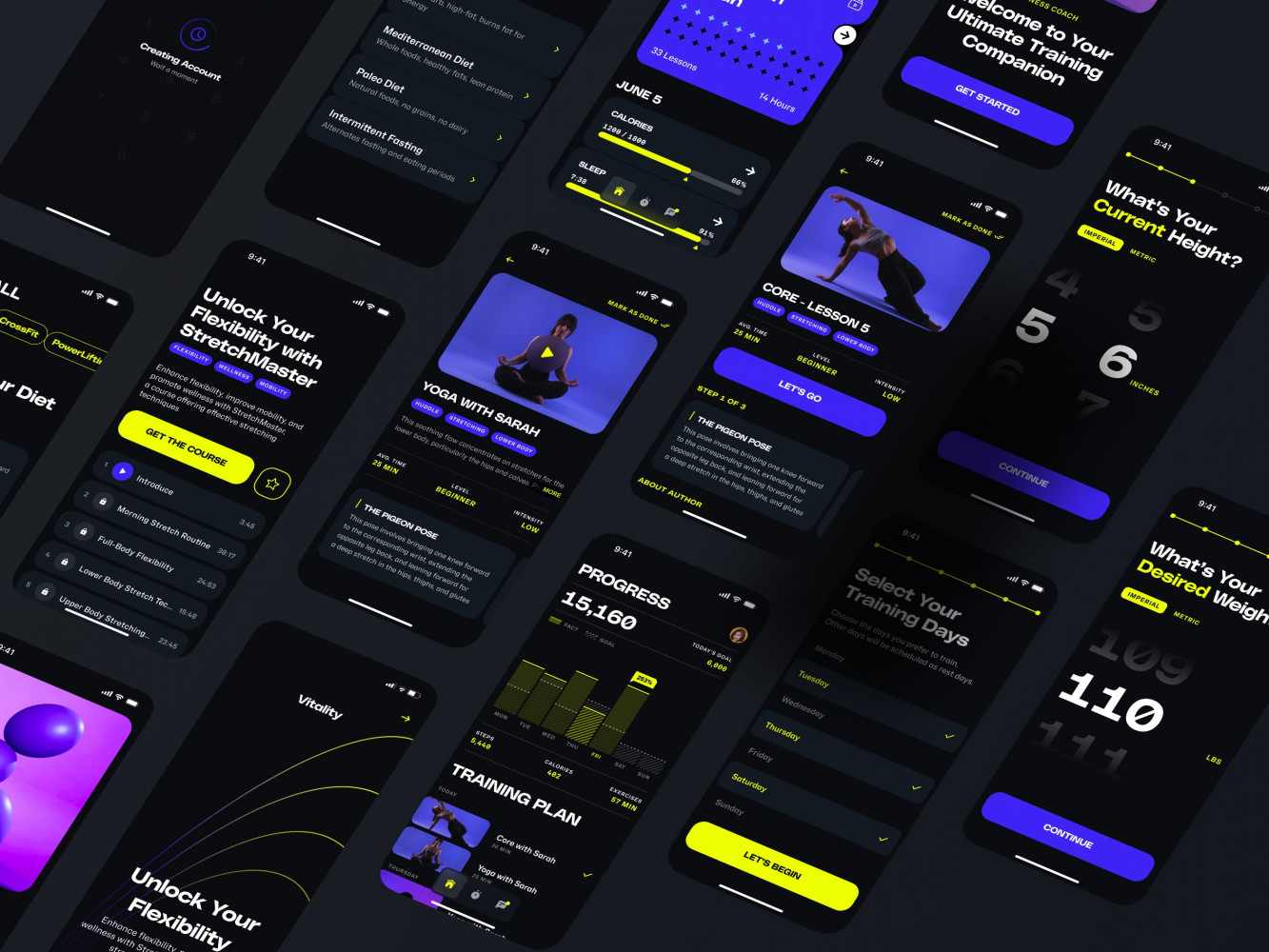
Mobile App Design for an Adaptive Fitness Guide by Shakuro
When Should You Go Native?
I’ve highlighted some reasons here and there, but let’s sum them up in a short list for your convenience.
When Performance Matters
Once again, if your application is doing anything heavy, like real-time video processing, complex animations, AR/VR features, or high-frequency data updates, native should be the only option.
Why? Because there’s no extra layer between your code and the device hardware. It just runs faster and smoother. Hybrid apps can try to keep up, but they often hit limits that force you into workarounds. And those workarounds tend to get messy fast.
When You’re Serious About iOS UX
iPhone users, beyond debate, have taste. They expect apps to behave a certain way: gestures, animations, transitions, even how menus slide in or how text fields respond to taps. If the action isn’t eye-catching or smooth, well, that ruins the impression of the whole product.
Native iOS application development means you’re building exactly how Apple intended. No fighting against the framework to make buttons or interactions similar to an iOS app when you already have all the elements.
So if your product needs to feel premium, say, you’re targeting enterprise clients or design-conscious consumers, native gives you that polish without extra effort.
When You Plan to Scale
Everything grows. If you have the right conditions, of course, but still. What starts as a simple MVP today could become a full-blown platform tomorrow. And if you’re planning for scale, native tends to age better than hybrid solutions.
Native codebases are easier to extend, test, and maintain over time. Less dependency on third-party plugins means fewer breaking changes when OS updates drop. And dealing with outdated libraries at scale is a nightmare nobody wants.
When You Need Deep Integration With iOS Features
Want to use Face ID, HealthKit, Siri shortcuts, widgets, background audio streaming, or even create multi-layered apps for Vision Pro?
Then, with native iOS development, you have direct access to all these tools, often right out of the box. Hybrid frameworks can support them, but usually through plugins that might not be updated, maintained, or fully tested. Which means bugs.
And if you’re building something that leans heavily on iOS-specific tech (like a camera-first app or health-tracking tool), native is the only way to go without running into walls later.
When You’re Pitching Investors or Enterprise Clients
When you demo your app to investors or big clients, you want it to feel solid. You want to impress them with everything you’ve got. Smooth animations, zero hiccups, no weird UI glitches. That’s where native shines.
I’ve heard more than one founder say how switching to native made their pitch meetings go smoother. People weren’t distracted by performance issues because they focused on the actual value of the product.
The same goes for enterprise clients. Big companies don’t want flaky tech. They want reliability. And native gives you that peace of mind.
When You Have the Budget and Timeline
True, native development usually costs more and takes longer than cross-platform options. Especially if you’re building both iOS and Android. It’s not a surprise: you need to polish all that cool-looking stuff for both versions. Twice as much money.
But it pays off in the long run. Fewer bugs, better scalability, and less rework down the line. You have to spend resources on fixing the m, too. So it’s like an investment in your peaceful future.
Still, if you’re bootstrapping or testing an idea quickly, hybrid can be smarter. Once you validate the concept and start thinking about growth, native becomes a better decision.
So, bottom line?
You should consider native iOS development when:
- Your app needs top-tier performance
- You care about the iOS user experience
- You’re planning to scale long-term
- You rely heavily on iOS-specific features
- You’re pitching investors or enterprise clients
- You’ve got the budget and timeline
- You’re already doing a major rewrite
Otherwise, hybrid or cross-platform might still be a valid option, especially for early-stage ideas or internal tools. But if you’re serious about building something lasting on iOS, native is still the gold standard.
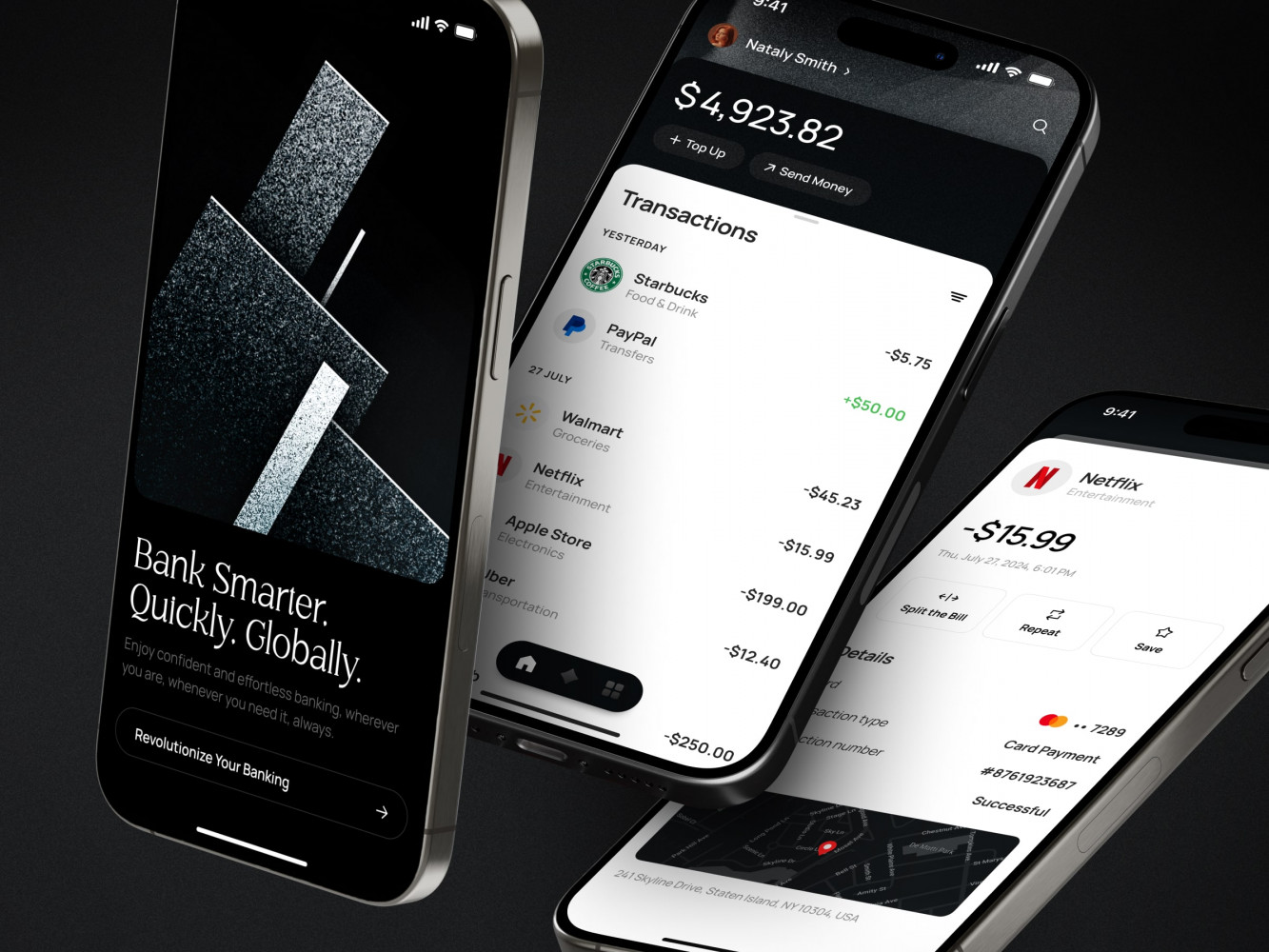
Finance Management Mobile App Design by Shakuro
Tools and Technologies We Use for Native iOS Development
If you’re trying to understand what your dev team is doing (or should be doing), here’s a real-talk breakdown of the main tools and technologies they’ll be using. Yes, I’ve mentioned them briefly when we dwelt on differences between native and hybrid approaches.
Xcode: The Main Playground
Xcode is Apple’s official IDE (Integrated Development Environment) for building iOS apps. Like a digital workshop where you use different parts to assemble the product.
It’s where devs write code, design interfaces, test on simulators, debug issues, and prepare the app for the App Store. And it’s the only one that fully supports Apple’s ecosystem. You have to use it if you’re going native; there is no way around it.
Swift: The Language That Feels Less Like Work
Apple introduced Swift back in 2014 to replace Objective-C, and it was a breath of fresh air.
Why do devs love it?
- Clean syntax—Less boilerplate, easier to read.
- Safe by default—Fewer crashes thanks to strong typing and error handling.
- Fast—Runs almost as fast as C++ for most tasks.
- Actively maintained—Apple keeps improving it every year.
If your team isn’t using Swift yet, ask why. Because unless they’re maintaining some ancient legacy code, there’s no good reason not to.
SwiftUI – Building UIs Without the Headache
Before SwiftUI came along in 2019, native iOS application development thrived on UIKit. It still works—and some teams stick with it because of legacy reasons—but SwiftUI changed the game.
With its help, you can build user interfaces declaratively. Instead of writing ten lines of code just to show a button, you just type in one. It’s faster, easier to maintain, and plays nicely with Swift features like Combine.
Yes, SwiftUI isn’t perfect because some complex animations or edge cases are still tricky, but for most modern apps, it’s becoming the go-to choice.
Combine: Managing Data Flow Like a Pro
When your app needs to react to changes, like a form field updating or data coming from an API, Combine helps manage that flow in a clean, organized way. It’s Apple’s answer to reactive programming, similar to RxSwift but built right into the OS. So if your app deals with real-time updates, forms, or async data, Combine makes life easier.
Of course, some teams still use NotificationCenter, delegates, or third-party tools like RxSwift, but Combine is gaining traction fast, especially with SwiftUI.
CoreData: Keeping Your Data in Check
If your app needs to store something locally, for example, user preferences, messages, or a list of items, CoreData is the go-to solution.
There are a few downsides: it has a learning curve and can feel clunky at times. But once you’ve got everything set up, the tool is super reliable. Unlike simple solutions like UserDefaults, CoreData can handle large, structured datasets with relationships. Some teams prefer alternatives like Realm or SQLite, but again, CoreData is built by Apple and integrates seamlessly with Swift and SwiftUI.
ARKit: Making Your App Feel Like Magic
Want to build something cool like an AR measuring app, a virtual try-on feature, or even a game where characters jump out of the screen? Then this tool is a must-have for native iOS app development.
It’s Apple’s framework for augmented reality. Using the iPhone’s camera and motion sensors, the tool blends digital objects with the real world. ARKit is powerful and surprisingly accessible these days.
Unit & UI Testing Tools: Catching Bugs
You don’t want users finding bugs before you do. That’s why you need unit tests and UI tests.
Unit tests check individual pieces of logic, like whether a function returns the correct value. UI tests simulate real user interactions, for example, tapping buttons, filling forms, and navigating screens, to make sure everything works as expected.
Apple provides XCTest, which is baked into Xcode. Some teams also use third-party tools like Quick/Nimble for more readable tests, but XCTest is solid for most projects.
CI/CD Practices–Automating the Boring Stuff
Continuous Integration/Continuous Delivery (CI/CD) is how teams automate testing, building, and deploying their apps.
Every time a developer pushes new code, tests run automatically. If everything passes, a new build gets created, and sometimes even deployed to TestFlight or the App Store. Tools like GitHub Actions, Bitrise, Fastlane, or GitLab CI help automate this process. Fastlane, in particular, is super popular for automating app signing, screenshots, and releases.
Without CI/CD, releasing an update becomes a manual, error-prone nightmare. With it? Just hit “merge” and watch the magic happen.
📦 Bonus Tools Devs Actually Use
Here are a few other tools that often pop up in native iOS application development:
- CocoaPods/Swift Package Manager (SPM)–For managing third-party libraries.
- Firebase/AWS Amplify–For backend services like authentication, storage, or analytics.
- TestFlight–Apple’s official tool for beta testing.
- App Store Connect–Where you submit and manage your app on the App Store.
- Sourcery–Code generation tool to reduce boilerplate.
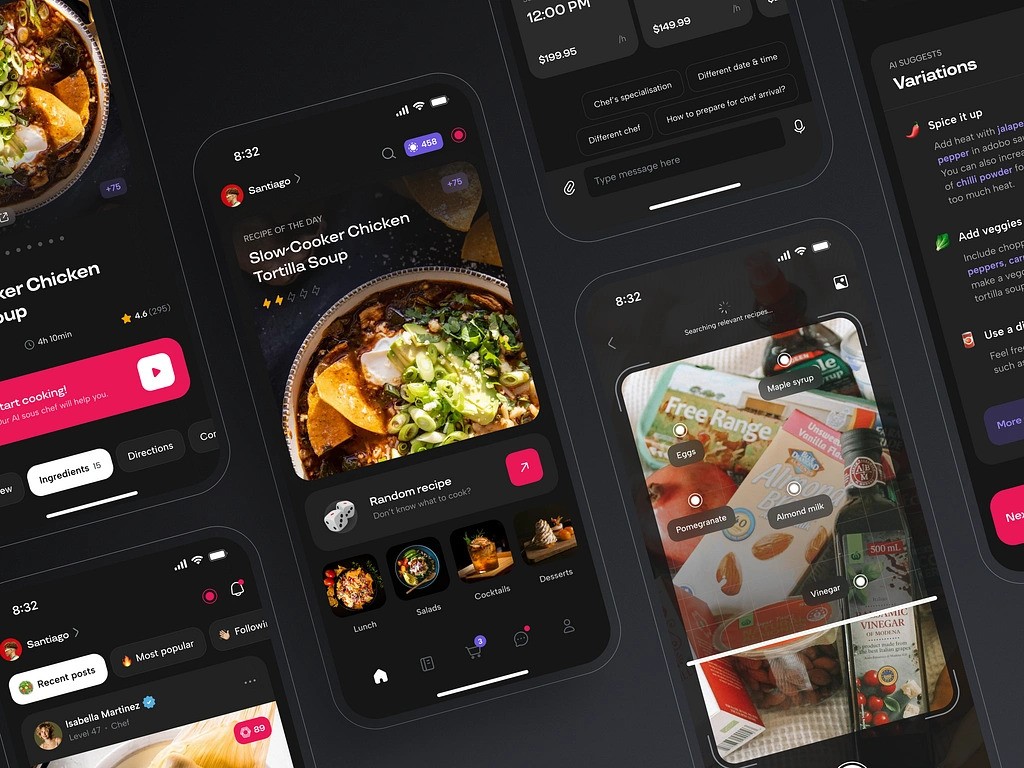
AI Chef Mobile App by Shakuro
Native iOS App Development Process at Shakuro
To describe the general steps, I’ll take Shakuro’s process as an example. Mind you, the team follows the best industry practices and supports a close collaboration between frontend, backend, and designers. So yeah, it’s a solid-looking example.
Discovery & Ideation
Okay, first things first, the team figures out what exactly you want to build. There should be a big picture before diving into code. This step prevents many challenges later on, when you try to come up with ideas during the actual development. Together with you, the managers work on the concept and ask questions like:
- What problem does the app solve?
- Who’s using it?
- What features are must-haves vs nice-to-haves?
- Any technical constraints or third-party tools needed?
UX/UI Design the Apple Way
Once the concept is ready, time to sketch out the looks and user interactions. How they will reach their goals, what screens they will see, where the buttons should be to speed the flow, etc. At this level, you get a low-fidelity prototype enough for primary testing. And early testing is a must-have, because only this way can you find sneaky bugs or redundant parts, which will cost a lot of resources to remove later.
In case the team picked SwiftUI for the tech stack, the devs can build basic UIs right in code during this stage to test ideas faster.
Our UI/UX designers also think about:
- Navigation flow
- Gestures
- Accessibility
- Dark mode support
- Device compatibility (iPhone vs iPad)
And yes, this matters even if you’re building an MVP. Because nobody wants to use an app that feels clunky or confusing.
Agile Development with Native Tools
While designers are polishing the looks, the developers do not let the grass grow under their feet. As an iOS native app development agency, Shakuro follows industry standards, including Agile and Scrum philosophies. So the team breaks things into sprints to move faster with small chunks and daily check-ins. These iterations allow frequent testing and full control over the process.
The development stages usually look like this:
- Start with core architecture and networking
- Build out the main screens one by one
- Add animations, gestures, transitions
- Integrate with APIs, databases, and push notifications
- Handle offline states, error handling, and performance tweaks
QA & App Store Submission
No app is perfect on day one, but you shouldn’t be shipping obvious bugs either. That’s why the team also provides additional, meticulous testing of different types:
- Unit tests: Check small pieces of logic (e.g., does this function return the right value?)
- UI tests: Simulate taps, swipes, and navigation to make sure everything works end-to-end
- Manual QA: Real humans clicking around, trying to break stuff
- TestFlight: Apple’s official beta-testing tool to share builds with real users
Thanks to a CI/CD pipeline, most of this is automated. That means every time someone pushes new code, tests run automatically, and you catch issues early.
Once the tests are done, time to show the world your beautiful creation. But submitting to the App Store isn’t just hitting “upload” and calling it a day. There’s a checklist that includes app icon, screenshots, metadata, privacy labels, etc. Also, setting up crash reporting tools like Sentry, Firebase Crashlytics, or App Center, because even after launch, things will go wrong eventually. Moreover, the App Store approval process can take up to three days.
Luckily, the native iOS app development company does all that work for you.
Ongoing Support & Scaling
Just because the app is live doesn’t mean the job is done. You probably want to add more features, polish a few things, remove some missed bugs, etc. Shakuro keeps taking care of your product after the release.
The team does:
- Regular updates (to fix bugs, add features, support new iOS versions)
- Performance monitoring
- User feedback loops
- Analytics and growth hacking

High-End Chauffeur Service App by Shakuro
Native iOS App Examples from Market Leaders
When you’re trying to decide whether to go native for your iOS app, it helps to see what the big players are doing.
I mean, Uber, Slack, LinkedIn, Apple Music, and other giants. They deliver special experiences you will hardly mix up. And 99% of them are built natively for iOS.
🚖 Uber
If you’ve ever used the Uber app on an iPhone, you know how smooth it feels. Maps zoom in with buttery animations, ride requests pop up instantly, and the whole thing responds almost instantly.
Uber uses Swift (and some Objective-C leftovers) under the hood, and their UI is mostly built with UIKit, though I’d bet they’ve been experimenting with SwiftUI modules too.
Why does that matter? Because when you’re dealing with real-time location tracking, dynamic pricing updates, and live ETAs, every millisecond counts. People won’t waste time waiting while fancy buttons load. Native iOS application development gives Uber direct access to GPS, background services, and push notifications without lag or weird hacks.
And if you’ve ever had an Uber driver cancel last minute and seen the next car pop up immediately—yeah, that kind of responsiveness isn’t magic. It’s solid architecture, running on native code.
💬 Slack
Slack is another great example of native done right. The iOS app is fast, searchable, and handles massive amounts of data without freezing or crashing, which is no small feat when people have hundreds of channels and thousands of messages.
Back in the day, Slack tried React Native for some parts, but they ended up moving back to native Swift. Why? Because performance suffered. And nobody wants a chat app that feels slow. So now, Slack leans heavily on Swift, Combine, and SwiftUI components where possible. Their team has even open-sourced some internal tools to help other devs manage complex UIs more efficiently.
The takeaway here is the following: even if you start hybrid, native can give you that extra edge when performance and polish matter most.
🏢 Select
I’ll give you one more example, featuring native iOS app development, this time from Shakuro’s portfolio.
Select is a private membership community with a huge user base around the world. So the app is the main source of its connection with users. And at that time, the iOS application was too outdated both technically and visually.
In less than four months, Shakuro revamped the product. The new design got an icon set, dark theme, custom map, and an upgraded concierge option. Moreover, the whole user flow was rebuilt from the ground up.
As for development, the game got trickier here. Select has partnerships across multiple industries, and the number hits around 1,300,000+ services. So, a custom approach was a must.
With tools like Xcode, Swift, UIKit, and CocoaPods, the team wrapped the hotel search partner API with search and reservation features into a well-organized UI. For additional assistance, Shakuro implemented a concierge service, where real humans helped paid members with reservations or bookings.
In the end, the Select app got a new life and won the hearts of the users. It keeps growing and getting updates, functionality, and materials.

Select app by Shakuro
Choosing the Right Native iOS App Development Agency
Look for Real iOS Expertise
This one sounds obvious, but you’d be surprised how many agencies slap “iOS development” on their website without really knowing the platform inside out.
To avoid this trap, ask the following questions during the meetings:
- What iOS projects have they shipped recently?
- Do they use Swift or still rely heavily on Objective-C?
- Are they familiar with SwiftUI, Combine, CoreData, etc.?
- Have they dealt with Apple-specific stuff like App Store submissions, push notifications, and widgets?
A solid team should live in Xcode, not just dabble in it. So yeah, make sure they’re hands-on with iOS.
Portfolio > Pitch Deck
Yes, agencies can make beautiful websites and pitch decks, but what have they actually built?
Go beyond screenshots and case studies. Try to find real apps they’ve made on the App Store. Download and check them out yourself. Do they feel smooth? Or too slow? That tells you more than any slide deck ever could.
And if possible, ask for references, especially from clients who also require native iOS application development. This will help you avoid bad deals.
Beware of “Cheap” and “Fast” Promises
Everyone wants to save money and ship fast. That’s totally fair. But there is a “but”.
If an agency promises a complex app in two weeks for $5k, something’s off. Either corners are getting cut, or the timeline is unrealistic, or both. Development takes time when it’s done right and you care about performance, scalability, user experience, and other essentials. So yes, budget matters, but value matters more.
Make Sure They Understand Your Business Goals
Seek more than just coders. Look for partners who care about your product’s success. You will understand their attitude based on what questions they ask in return.
For example, business partners ask about:
- Who your users are
- How do you plan to monetize
- What your growth strategy looks like
- What makes your idea different
Because at the end of the day, they’re helping you build a business. And to be honest, their success depends on the success of your product. If they treat your project like just another ticket on their list, move on.
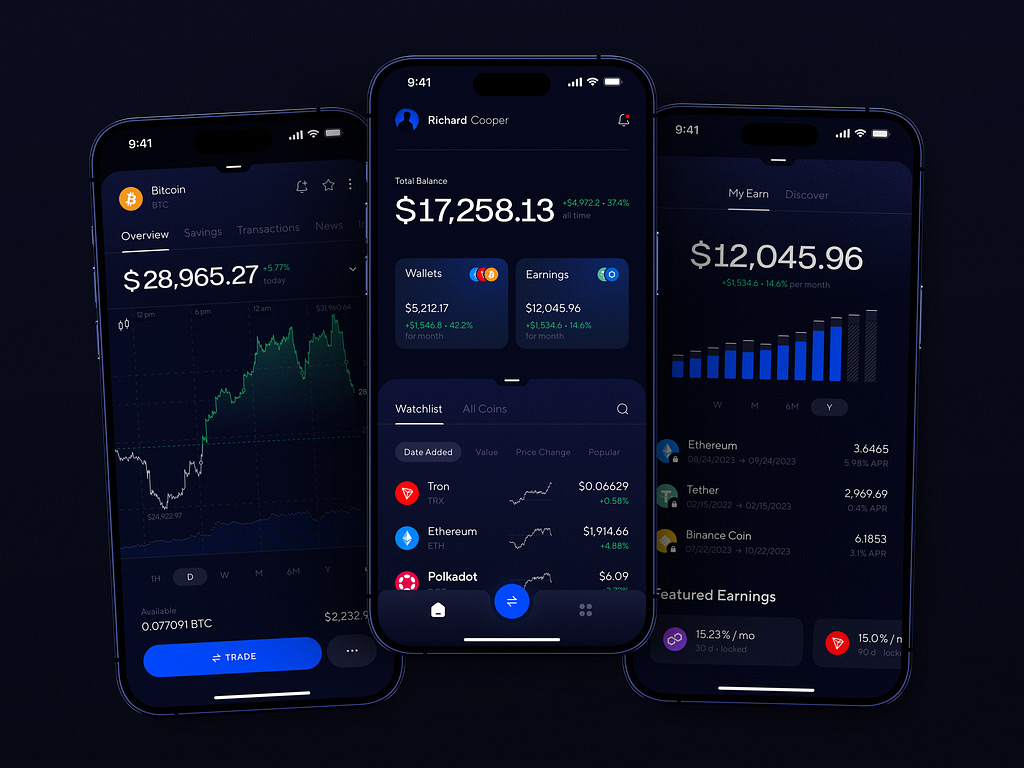
Abyss Crypto Management App by Conceptzilla
How Much Does Native iOS App Development Cost?
Budget is always a big question mark when you’re starting out or expanding an existing product. But the answer isn’t as simple as slapping a number on the table.
In short, it depends on the scope. A simple MVP with just a few screens and a mid-sized app with user accounts, push notifications, etc., will have different costs. Not to mention a full-blown enterprise-grade product with complex features like AR. Each of these will land you on opposite sides of the price range.
Let’s start with a small app or a basic MVP. For example, it has features like a to-do list, a basic calculator, or something that proves your idea works without too many moving parts. These types are usually good for validating early concepts or testing market fit. The app is not super fancy, but enough to get off the ground. The approximate cost of such an MVP is estimated at around $10k–$25k.
A mid-sized app is more common for startups. It usually has login/signup, API integrations, cloud storage, push notifications, or in-app purchases. You’re building something functional, scalable, and ready for real users. To build it, you will need around $30k–$75k.
Enterprise-level products, social networks, media-heavy apps, or anything with advanced tech like video streaming, ARKit, machine learning, or custom animations are hungry for resources. If you’re creating something ambitious, like a health-tracking platform with sensor integrations or a marketplace with real-time updates, expect to be in this ballpark: $80k – $200k+.
As you can see, the key cost drivers are complexity, features, and integrations. The more you add up, the more money you will have to pay. And time to spend. Are there any ways to save up resources when diving into native iOS application development?
Cost-Saving Tips
- Start with an MVP that validates your idea: Focus on the core feature that solves your user’s problem. Strip away the extras. No fancy animations, no extra screens, just enough to test if people actually want what you’re selling.
- Hire a small, but experienced team: A tight team moves faster, communicates better, and usually charges less than an agency with 20 people on payroll. Just make sure they’re communicative and reliable, because coordination issues will cost you more than you save.
- Re-use native components: iOS has a ton of built-in tools: buttons, forms, navigation bars, lists, sheets, gestures, you name it. Use them! Trying to rebuild them from scratch just to make things “unique” burns time and budget, and often backfires.
- Leverage existing backend tools: You don’t necessarily need a custom backend on day one. Firebase and other platforms enable you to sidestep months of backend development and get started building immediately. They are sufficiently scalable for early days, and you can always switch over to custom implementation later once you’ve validated your concept.
Why going native is cheaper in the long run? It might seem at first to be the more expensive, longer route. Cross-platform or hybrid apps provide faster builds, lower expense, and “write once, run everywhere.” What feels cheaper up front, however, is more costly in the long run. And if you include performance, support, and scalability, native iOS development is usually the smarter, cheaper choice.
For example, you may save time initially with React Native or Flutter, and six months later, your users are complaining about delay and slow response from buttons. Additionally, hybrid frameworks typically rely on third-party libraries or wrappers in order to access native components. That is okay until Apple comes along and does an iOS update, and something is broken.
So, over time, it saves you from headaches, rewrites, lost users, and wasted budget.
Final Thoughts: Native iOS is the Gold Standard for Apple Users
There are times when hybrid or cross-platform makes sense, for example, when you’re testing an idea fast or building something simple. But if you care about performance, user experience, scalability, and long-term maintainability, native iOS development still stands out as the best option.
It might cost a bit more at the early stages, take a little longer to build, and require a team that really knows what they’re doing, but those early investments pay off.
You end up with an app that feels smooth, runs reliably, integrates deeply with iOS features, and scales as your product grows. You avoid technical debt that haunts you later, reduce maintenance headaches, and deliver something users actually enjoy using.
So, if you are looking for an iOS development company to bring your app idea to life, reach out to us. The Shakuro team will suggest a suitable approach that will help you reach your business goals and solve the users’ problems.

